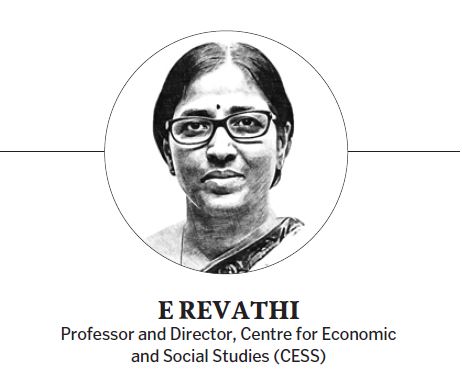In India, around 41% of women in rural areas and 48% in urban areas reported that child care and personal commitments at home are the reasons for not working or not seeking work (PLFS 2021)
Updated On – 01:11 AM, Thu – 12 October 23

By E Revathi
The Henry Lee Prof of Economics Claudia Goldin from Harvard University received the most coveted Nobel Memorial Prize in Economic Sciences ‘for having advanced understanding of women’s labour market outcomes’. Her work focused on identifying the drivers of gender differences in the labour market. Claudia Goldin has extensively worked on issues of women related to employment and the labour market as managing between career and family, the impact of birth control pills on woman’s career and marriage decisions, women’s surnames after marriage as a social indicator and the new lifecycle of women’s employment.
It is rewarding and recognises the importance of inclusiveness in labour markets, segmented by race, ethnicity, gender, and closer home, religion and caste. Goldin has analysed 200 years of data from the US to find the gender differences in earnings and employment rates. The paper titled ‘The U-shaped Female Labour Force Function in Economic Development and Economic History’, published in 1994 by the National Bureau of Economic Research, provided a comprehensive account of women’s earnings and labour market participation through the centuries and revealed the causes of change as well as the main sources of the remaining gender gap.
She studied the long-term change in social and economic spheres from the perspective of economic history and comparative studies. She took forward this perspective from her mentor Bob Fogel, who was awarded the Nobel Prize in 1993 for his studies on slavery in the US and how the railroad has played a development role in the economy. He himself was a student of Nobel laureate Simon Kuznets.
Her long view as a historian combined with economist’s precision revealed how women have made long-term gains in the labour market but still, true equity remains elusive.
Women’s Contribution
Claudia Goldin’s work on more than 100 countries, along with the American economy, from a historical perspective shows an initial decline in women’s work participation due to a strong income effect (rise in consumption due to rise in income). She has shown that female participation in the labour market did not have an upward trend over a long period of 200 years in the US, a matured capitalist economy, but has taken a ‘U shape’ curve whereby married women participation decreased with the transition of the economy from an agrarian to industrialised economy in the early 19th century.
However, it started to increase with the growth of the service sector in the early 20th century. As the economy transitions to the service sector, women’s participation in the labour market rises along with a rise in their education levels. Women faced with the burdens of managing the home and taking care of the children and elders (in short, the care economy) are at a disadvantage in the choices and compromises they make to accommodate the needs of the family. For example, women take up part-time work to accommodate family needs and, therefore, tend to be paid lower wages.
Structural change in the economy and evolving norms regarding women’s role in the family and their responsibilities are some explanatory factors for this phenomenon. All these make markets segmented across men and women and work differently for the two. Over the past 25 years (1995 to 2020), the gender gap in the labour force participation rate remained constant at 27% in the world. The global FLFPR (female labour force participation rate) was at 50% while it was 30% for India. The positive trend in the economic growth the world over has not translated into better employment participation for women. On the other side, while the global FLFPR fell to 46% by 2020, that of India declined to 24.5% in 2018 and improved to 29% in 2021-22.
India Scenario
The debate in India has thrown much light on the various factors for declining women’s labour market participation. Several studies came up in support of adding further complementary factors to explain the phenomenon. The unequal distribution of domestic work restricts women’s participation in paid work. Globally, women spend 2-10 times more than men on unpaid work. In India, around 41% of women in rural areas and 48% in urban areas reported that child care and personal commitments at home are the reasons for not working or not seeking work (PLFS 2021).
Another example to highlight the gender disparity in the labour market is the percentage of the young population (15-24 years) who are not in employment, education and training (NEET), which is 31% among women as against 14% among men at the global level. This shows indirectly the burden of care responsibility on girls and women. Another factor about women’s labour force participation is that it negatively correlates with the economic growth of a country indicating its labour force as a supplementary to falling income levels.
It is a well-known fact that equal participation of women in the labour market would enable a substantial rise in the economic growth of countries. Going by the IMF estimates, equal participation of women in the workforce increases India’s GDP by 27%. This is where policymakers must enforce legislations, policies and programmes to end all forms of discrimination and violence against women and ensure women and girls have equal access to education, health, food security, economic assets, skill development as well as employment. Moreover, an ILO study shows that doubling investment in care relative to the 2015 levels would generate 117 million additional jobs by 2030. Similarly, an investment of 2% GDP in care would create 11 million jobs in India of which at least 33% would be for women.
In States
The labour force participation rates for women across north India are substantially lower than that of south and west. South Indian States have performed best compared with the national average. Telangana is one of the States with a high FLFPR along with AP, Tamil Nadu, and central States like Chhattisgarh.
However, the nature of work participation holds the key. While all males’ participation in paid work is 78% that for females is 93% and the obverse is true for unpaid work. The average number of hours spent by women in the State in a day on unpaid domestic work is 4.43 hours and for males it is 0.55 hours, while for employment and related activities, it is 3.08 for women and 6.87 for men in the 15-59 years age-group. Time poverty (women having less time for paid labour) as conceptualised by researchers results in stress and fatigue and also material poverty as it reduces the quality of goods and services delivered through unpaid services.
What is the takeaway for policy? The research of Claudia Goldin and others on women’s labour market participation substantiates the need for a policy to invest more in the care economy to enable their participation which would result in higher economic growth overall and also concomitantly higher benefits to women and girls.






